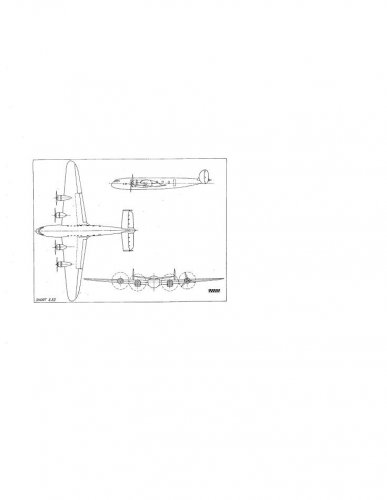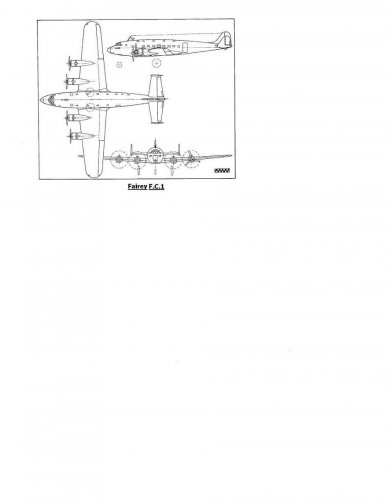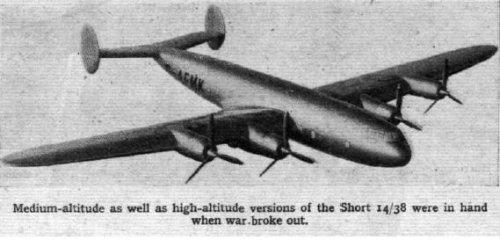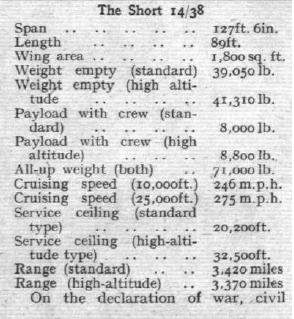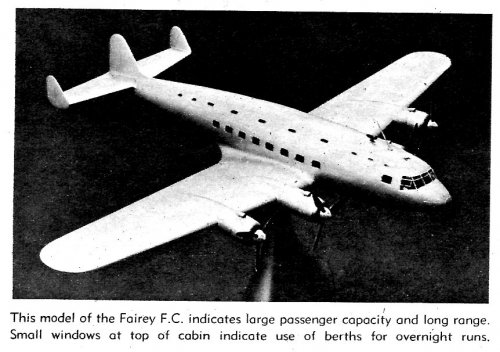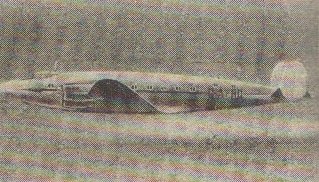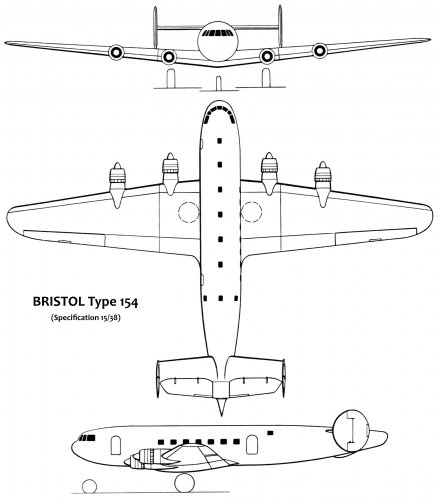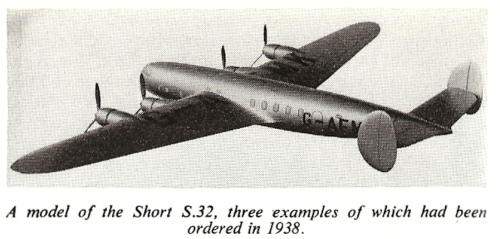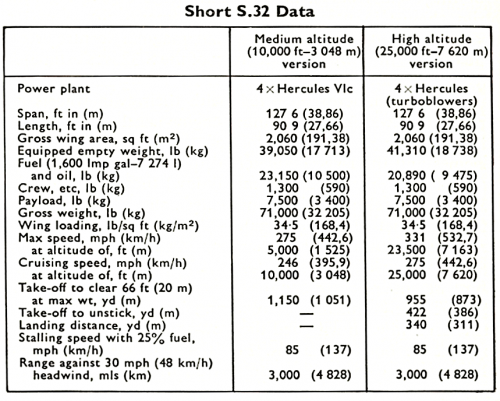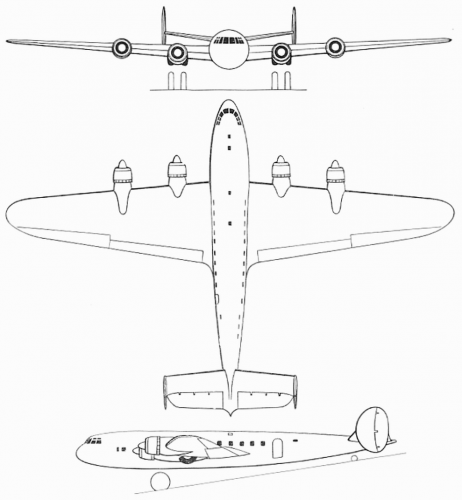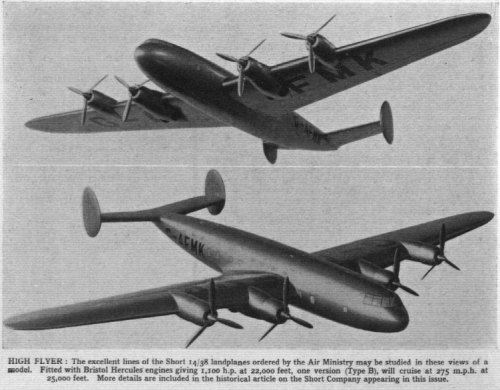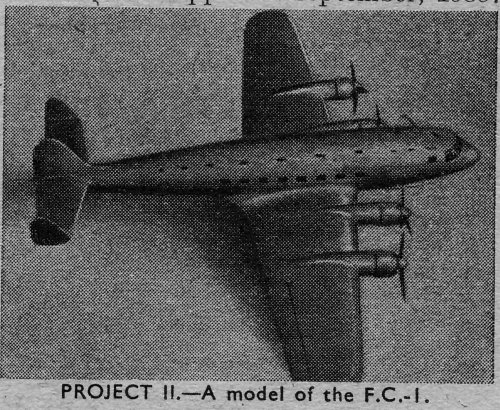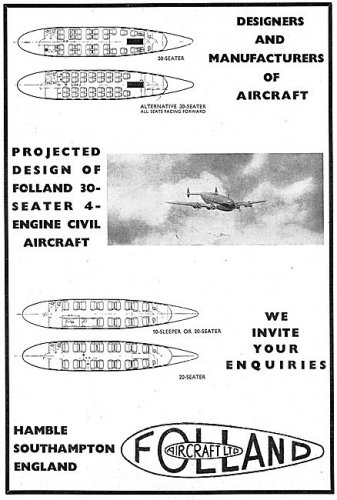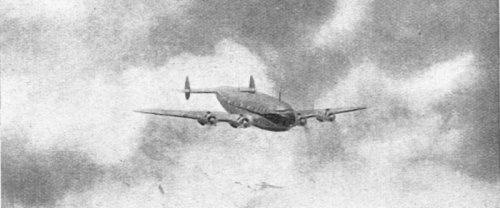You are using an out of date browser. It may not display this or other websites correctly.
You should upgrade or use an alternative browser.
You should upgrade or use an alternative browser.
British Specification 14 & 15/38 (Bristol 154, GAL-40, Shorts S.32)
- Thread starter PMN1
- Start date
ChuckAnderson
ACCESS: Confidential
- Joined
- 10 May 2006
- Messages
- 188
- Reaction score
- 33
Hi PMN1!
Here's some info I found on the Short S.32 Airliner.
My source for this information is:
Shorts Aircraft Since 1900
pp. 341-344
Author: C.H. Barnes
Revised By: Derek N. James
Original Publishers: Putnam Aeronautical Books, Great Britain
Publishers: Naval Institute Press, Annapolis MD, USA
Copyright C.H. Barnes 1967
New Material Copyright Derek James 1989
TECH DATA
Wingspan:............38.8 m (127' 6")
Length:...............27.7 m (90' 9")
Empty Weight:.....17,710 kg (39,050 lbs)
All-up Weight:......32,210 kg (71,000 lbs)
Performance:
Max Speed:.........443 km/h (275 mph) or
...................................530 km/h (330 mph) if pressurised at 7620 m (25,000 ')
Range: ..............5470 km (3,400 miles)
Chuck
Here's some info I found on the Short S.32 Airliner.
My source for this information is:
Shorts Aircraft Since 1900
pp. 341-344
Author: C.H. Barnes
Revised By: Derek N. James
Original Publishers: Putnam Aeronautical Books, Great Britain
Publishers: Naval Institute Press, Annapolis MD, USA
Copyright C.H. Barnes 1967
New Material Copyright Derek James 1989
TECH DATA
Wingspan:............38.8 m (127' 6")
Length:...............27.7 m (90' 9")
Empty Weight:.....17,710 kg (39,050 lbs)
All-up Weight:......32,210 kg (71,000 lbs)
Performance:
Max Speed:.........443 km/h (275 mph) or
...................................530 km/h (330 mph) if pressurised at 7620 m (25,000 ')
Range: ..............5470 km (3,400 miles)
Chuck
Attachments
lark said:It's all in Air Enthusiast (monthly magazine) of
September 1972. Volume 3 number 3.
"A Short Fairey Tale...still-born airliners of the 'thirties"
Yes, its an intresting article, i was wondering if any more had come to light since.
In fact ,not much more is found...
There is the extensive description (7p.)of the Fairey FC1 in
Fairey Aircraft since 1915- H.A.Taylor - Putnam
and a beautiful colour illustration of this project on page 86
of The Aeroplane ,October 2002.
There is the extensive description (7p.)of the Fairey FC1 in
Fairey Aircraft since 1915- H.A.Taylor - Putnam
and a beautiful colour illustration of this project on page 86
of The Aeroplane ,October 2002.
ChuckAnderson
ACCESS: Confidential
- Joined
- 10 May 2006
- Messages
- 188
- Reaction score
- 33
ChuckAnderson
ACCESS: Confidential
- Joined
- 10 May 2006
- Messages
- 188
- Reaction score
- 33
ChuckAnderson said:Hi Everyone!
Here's a three-view of the Fairey F.C.1.
Chuck
Hi Everyone!
I apologise for this three-view coming through small again. I'm still trying to correct this. Can you possibly enlarge this on your own computers?
Chuck
Two short clips of film are available on the movietone newsreal website - www.movietone.com.
The first is dated 1/12/38 story number34920 - entitled New Fairey transport plane, the second story is number 37129 from 3/8/39 and is titled FC1 mockup at fairey works.
worth watching
The first is dated 1/12/38 story number34920 - entitled New Fairey transport plane, the second story is number 37129 from 3/8/39 and is titled FC1 mockup at fairey works.
worth watching
- Joined
- 26 May 2006
- Messages
- 32,686
- Reaction score
- 11,909
The prospects for these designs were shot down by WW2, given what was required and what British aircraft and engine companies were capable of, could they specifications have been laid down sooner and still get the designs as they historically were?
- Joined
- 20 January 2007
- Messages
- 896
- Reaction score
- 918
Big spars and Big Power had become technically possible by 1935, thus specified by Air Ministry as big Bombers emerging as Warwick, Manchester, Stirling, Halifax, and as big MR, emerging as Sunderland and Lerwick. So the A to your Q is that, if Imperial Airways, UK's monopoly commercial buyer, had been disposed in 1935/36 not to marine but to big, long-range landplanes and had urged its owner to fund them, then bids would have come from more than Short's and Hendon-sawer Fairey.
DC-4/L-049 were initiated just after F.C.1/S.32; UK could have had such things underway by 1937...thus delaying mass deployment of effective Heavies even later than 1943. An HP monoplane successor to Hannibal would have been instead of, not as well as (to be) Halifax.
DC-4/L-049 were initiated just after F.C.1/S.32; UK could have had such things underway by 1937...thus delaying mass deployment of effective Heavies even later than 1943. An HP monoplane successor to Hannibal would have been instead of, not as well as (to be) Halifax.
Bailey
ACCESS: Secret
- Joined
- 24 July 2009
- Messages
- 308
- Reaction score
- 34
Hi, The following link might prove to be of interest.
http://www.flightglobal.com/pdfarchive/view/1942/1942%20-%202624.html
Regards Bailey.
http://www.flightglobal.com/pdfarchive/view/1942/1942%20-%202624.html
Regards Bailey.
- Joined
- 30 November 2007
- Messages
- 1,089
- Reaction score
- 430
I read somewhere (a long time ago) that the Short S32 shares the same wing as the G class flying boat and the Stirling bomber (though for the Stirling the wing was cropped at the tips); this makes sense especially as all 3 types are designed by the same team and are all powered by Bristol Hercules engines......
Can any one confirm this?
Terry (Caravellarella)
Can any one confirm this?
Terry (Caravellarella)
Just call me Ray
ACCESS: Top Secret
- Joined
- 26 August 2007
- Messages
- 672
- Reaction score
- 42
Ummm...is it ok in that I express my amazement in how much it resembles the DC-4E, even down to the window arrangement?
- Joined
- 25 June 2009
- Messages
- 13,780
- Reaction score
- 3,058
Here is the Bristol Type 154 submitted to specification 15/38 calling for a "Civil Air Liner".
Other contenders were the Fairey F.C.1, General Aircraft GAL.40, and an unspecified Folland project.
The F.C.1 won the tender, but the order was cancelled on October 17, 1939, for obvious reasons.
I'm also enclosing a very poor scan of the GAL-40. I'm sure someone can improve on this!
Other contenders were the Fairey F.C.1, General Aircraft GAL.40, and an unspecified Folland project.
The F.C.1 won the tender, but the order was cancelled on October 17, 1939, for obvious reasons.
I'm also enclosing a very poor scan of the GAL-40. I'm sure someone can improve on this!
Attachments
- Joined
- 1 May 2007
- Messages
- 2,460
- Reaction score
- 1,453
From "A Short Fairey Tale...still-born airliners of the 'thirties" :-
cheers,
Robin.
cheers,
Robin.
Attachments
-
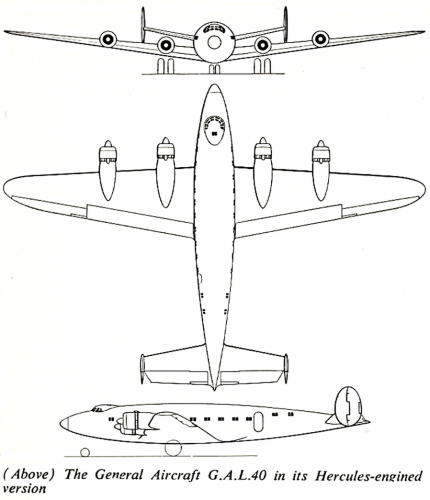 G.A.L. 40 3-view.png421.3 KB · Views: 200
G.A.L. 40 3-view.png421.3 KB · Views: 200 -
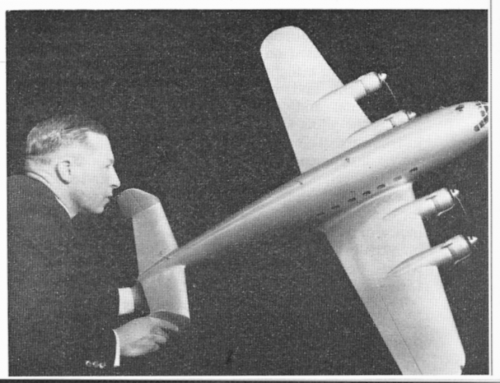 Fairey F.C.1 model#2.png452.9 KB · Views: 156
Fairey F.C.1 model#2.png452.9 KB · Views: 156 -
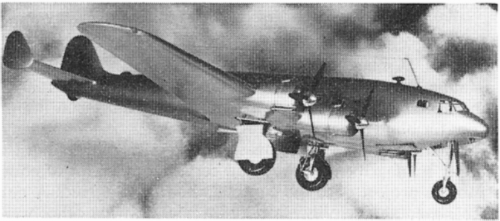 Fairey F.C.1 model#1.png327.9 KB · Views: 521
Fairey F.C.1 model#1.png327.9 KB · Views: 521 -
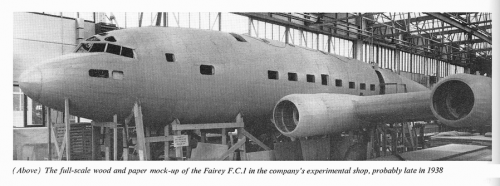 Fairey F.C.1 mock-up.png319.3 KB · Views: 521
Fairey F.C.1 mock-up.png319.3 KB · Views: 521 -
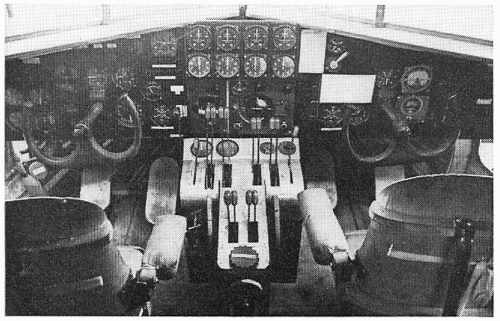 Fairey F.C.1 flight deck mock-up.png790.5 KB · Views: 667
Fairey F.C.1 flight deck mock-up.png790.5 KB · Views: 667 -
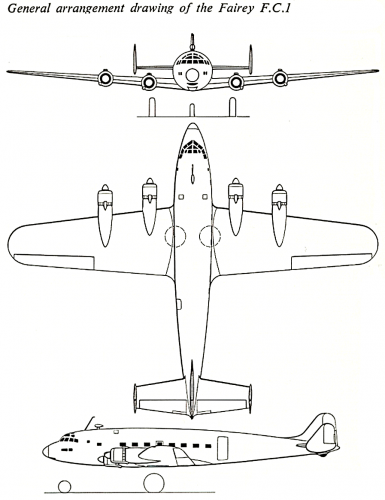 Fairey F.C.1 3-view.png364 KB · Views: 748
Fairey F.C.1 3-view.png364 KB · Views: 748 -
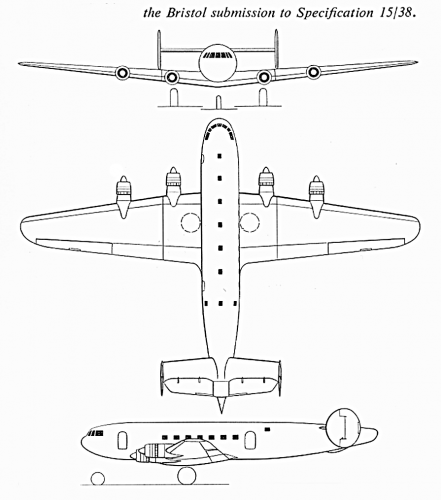 Bristol 15slash38.png167.3 KB · Views: 817
Bristol 15slash38.png167.3 KB · Views: 817
- Joined
- 1 May 2007
- Messages
- 2,460
- Reaction score
- 1,453
- Joined
- 25 June 2009
- Messages
- 13,780
- Reaction score
- 3,058
lark said:There was already a thread about the
Fairey FC1 and Short S.32
started by PMN1 on September 26 2006.
The searchfunction is still your friend...
I'd rather this kind of remark was done by PM...
For your information, I DID use the search tool (as I ALWAYS do) by entering "Bristol 15/38" and nothing relevant came of it...
Maybe this could be usefull..
Project numbers were not given (by Folland) to a 1939 four-engine ,transatlantic monoplane
to Spec. 14/38 to which Short and Miles responded,or to a medium range airliner to Spec.15/38
of the same year which brought responses from the Fairey Aviation and General Aircraft companies.
On the other hand ,from the same source: Fo106A-Four engined medium civil transport to either
C.14/38 or C.15/38 with Bristol Taurus engines ,August 1938.
So far the Project File from: Spirit of Hamble,Folland Aircraft-Derek N.James,Tempus Publ.2003.
No illustrations.
Project numbers were not given (by Folland) to a 1939 four-engine ,transatlantic monoplane
to Spec. 14/38 to which Short and Miles responded,or to a medium range airliner to Spec.15/38
of the same year which brought responses from the Fairey Aviation and General Aircraft companies.
On the other hand ,from the same source: Fo106A-Four engined medium civil transport to either
C.14/38 or C.15/38 with Bristol Taurus engines ,August 1938.
So far the Project File from: Spirit of Hamble,Folland Aircraft-Derek N.James,Tempus Publ.2003.
No illustrations.
- Joined
- 25 June 2009
- Messages
- 13,780
- Reaction score
- 3,058
lark said:Maybe this could be usefull..
Project numbers were not given (by Folland) to a 1939 four-engine ,transatlantic monoplane
to Spec. 14/38 to which Short and Miles responded,or to a medium range airliner to Spec.15/38
of the same year which brought responses from the Fairey Aviation and General Aircraft companies.
On the other hand ,from the same source: Fo106A-Four engined medium civil transport to either
C.14/38 or C.15/38 with Bristol Taurus engines ,August 1938.
So far the Project File from: Spirit of Hamble,Folland Aircraft-Derek N.James,Tempus Publ.2003.
No illustrations.
I believe 15/38 and C.15/38 are one and the same spec, although I'm not sure the actual documents use the "C.".
Thanks for the info!
- Joined
- 6 November 2010
- Messages
- 4,228
- Reaction score
- 3,164
15/38:
Source: 'The British Aircraft Specifications File' by KJ Meekcoms and EB Morgan, Air Britain, 1994.It is intended that the aeroplane shall be in production not later than the summer of 1940, and that it should compare favourably with such aeroplanes of similar class as will then be on the world market.
14/38Requirements
Long Range Civil Land Plane
(Appendix B [C.3851] only)
File no. 754692/38
Issued to Short Bros.
-- Specification held in abeyance --
It is required to develop a type of all metal, long-range landplane suitable in all respects for operation on scheduled air services. Two versions of the aeroplane are required, the first with an operating height of 10,000 ft. and the second with an operating height of between 20,000 ft and 25,000 ft.
With 18 passengers, a payload of 7,500 lb is required. The accomodation should be capable of housing in comfort 18-20 day or night passengers, and a small promenade should also be provided. The mean cruising speed is to be not less than 250 mph at 10,000 ft or not less than 275 mph at 20,000-25,000 ft, when using the engine maker's recommended maximum economic cruising power. The range is not to be less than 3,000 miles against a 30 mph headwind when carrying the specified crew and payload at the above speed. The passengers' and pilots' compartments should be supercharged to simulate conditions at 4,000 ft when flying at 20,000-25,000 ft. Stability and controllability, particularly at "low" speeds, will be regarded as an important feature of the design.
The aircraft must be fitted with an Automatic Pilot and an approved form of anti-icing or de-icing equipment should also be provided.
Crew: 1 Commander, 1 First Officer, 1 Navigator, 2 W/T Operators, 2 Stewards.
Radio: Medium and short wave receiver and transmitter, Independent medium wave D/F receiver with rotatable loop, VHF approach receiving equipment.
The aeroplane, fully loaded, is to comply with the requirements for normal category certificate of airworthiness. When fully loaded it must clear a 66 ft screen in not more than 1,200 yards. It must comply with the normal category requirements of AP.1208, Design Leaflet F1, paragraphs 2, 3 and 4, when carrying full complement of crew, payload and equipment and fuel for 25% of the specified range.
The details of the aircraft should be designed for easy maintenance and the ability to change an engine in one hour is considered desirable.
Short Bros. was awarded Contract no. 762587/38 for three prototype S.32s, one of which was to be pressurised. C/ns S.1022-4 were alloted and registrations G-AFMK to G-AFMM were reserved. Three fuselages were built; these were shown to the King and Queen during their visit to Rochester on 14/3/39. Both Miles (M.26) and Folland were developing projects when the war intervened. The specification was cancelled on 13/11/39.
15/38Requirements
10-30 Seater Civil Air Liner
Dated 17/5/38
File no. 759518/38
Issued to Tender. (Fairey FC.1)
-- Specification held in abeyance --
A four-engined all-metal monoplane civil airliner is required, suitable for both short and long range operation on scheduled air lines. It is intended that the aeroplane shall be in production not later than the summer of 1940, and that it should compare favourably with such aeroplanes of similar class as will then be on the world market. This specification (issued by the Director of Civil Research and Production) is intended to define the type of air liner needed in broad outline only. The constructor is expected to fill in the details to suit prospective English and foreign customers. The same basic design must be adaptable for use as a long range machine carrying 10 passengers and as a short range machine carrying 30 passengers.
Performance: LR version.
Fuel and oil for 1,850 miles against a 30 mph wind with 25% fuel reserve, when cruising at not less than 200 mph at a height not exceeding 12,000 ft and with engines not exceeding 50% of the maximum continuous rated power available for climb at 12,000 ft. The stalling speed should not exceed 68 mph. Five crew, 2 pilots, 1 wireless operator, 1 flight engineer and 1 supernumerary. Plus 1 steward, and 10 passengers.
Performance: SR version.
Fuel and oil for 200 miles allowing for a 40 mph head wind and reserve for one hour's flight, when cruising as for LR version. Three crew, 2 pilots, 1 wireless operator. Plus 1 steward, and 30 passengers.
Preference will be given to an aeroplane the total weight of which does not exceed 42,000 lb in either long or short range version. Tankage is to be provided for a still air range of 3,000 miles under the crusing conditions for the LR version. The undercarriage must be retractable into the wings in no more than three seconds.
Engines: Any approved British engines may be used, with the proviso that if it is desired to use engines at present on the secret list, the prior permission of the Air Ministry must be obtained. Preference will be given to a design incorporating air-cooled engines. The design is to make provision for fitting higher-powered engines in case these should be needed during the useful life of the type.
W/T equipment: Outside Europe, the aeroplane must be equipped with short wave and medium wave W/T transmission and reception. When intended for operations solely within Europe, medium wave W/T transmission and reception only is required; Medium wave DF receiver with loop; VHF landing approach receiving equipment. An automatic pilot must be fitted.
Tender invitations were sent to Armstrong Whitworth, Bristol, Fairey, General Aircraft and Vickers. Folland also indicated an interest. Fairey submitted drawings and proposals on 4/7/38. Drawings and proposals were also submitted by General Aircraft (GAL.40) and Bristol (Type 154). Fairey agreed toproduce two FC.1 prototypes plus 12 production aircraft, powered by Bristol Taurus or Wright Cyclones for overseas sales. An order was placed on 4/3/39. A mock-up was constructed. The project was cancelled on 17/10/39.
- Joined
- 22 April 2012
- Messages
- 2,318
- Reaction score
- 1,839
Flight article from January 1939, interestingly it says that the Fairey FC.1 was to have a pressure cabin. Vickers aircraft since 1908 also states that Fairey had been working on pressure cabin technology to support commercial airliner projects and Vickers were thus asked to cooperate with them on the pressurised Wellington project.
http://www.flightglobal.com/pdfarchive/view/1939/1939%20-%200153.html
http://www.flightglobal.com/pdfarchive/view/1939/1939%20-%200153.html
- Joined
- 19 October 2012
- Messages
- 1,917
- Reaction score
- 1,766
There are some GAL 40 documents, at the very least 3-view blueprints, possibly the original tender document, in an archive where I help out. I'll check next time I am there, probably in a few weeks
- Joined
- 19 October 2012
- Messages
- 1,917
- Reaction score
- 1,766
So...after a long delay I now have a copy of the original GAL-40 tender document. If anyone has any questions regarding the project I should be able to provide answers
- Joined
- 25 June 2009
- Messages
- 13,780
- Reaction score
- 3,058
Schneiderman said:So...after a long delay I now have a copy of the original GAL-40 tender document. If anyone has any questions regarding the project I should be able to provide answers
Great news!
- Joined
- 6 November 2010
- Messages
- 4,228
- Reaction score
- 3,164
There is a related thread here: http://www.secretprojects.co.uk/forum/index.php/topic,849.msg6562.html#msg6562 - I'd say an obvious candidate for merging.
It started as a discussion of specification 15/38, eventually the very much related specification 14/38 popped up. Mods?
Done, thanks for the clue !
It started as a discussion of specification 15/38, eventually the very much related specification 14/38 popped up. Mods?
Done, thanks for the clue !
SlickDriver
ACCESS: Confidential
- Joined
- 20 June 2006
- Messages
- 161
- Reaction score
- 28
"So...after a long delay I now have a copy of the original GAL-40 tender document. If anyone has any questions regarding the project I should be able to provide answers"
Since nobody else asked the most obvious question - I will. What details does the tender document for the GAL-40 have that we are not aware of via other sources?
Since nobody else asked the most obvious question - I will. What details does the tender document for the GAL-40 have that we are not aware of via other sources?
- Joined
- 19 October 2012
- Messages
- 1,917
- Reaction score
- 1,766
As far as I am aware only the basic data on the project has been published; dimensions, weight, speed etc., with the article on the Fairey FC2 in Air Enthusiast in 1972 being the source for most of this. The tender, obviously, has much more on the details and covers construction information; wing, pressure cabin, UC, flaps, fuel tankage, APU, passenger accommodation and so on. Nothing dramatic but enough to demonstrate that GAL had gone to a great deal of effort on the design. Without being able to compare with Fairey's submission it is hard to see why they lost the contract, but it may have just come down to lack of proven expertise with advanced aircraft or a lack of production space.
- Joined
- 19 October 2012
- Messages
- 1,917
- Reaction score
- 1,766
Located at last 
 , the Folland designs, Fo106A, for one or other of these specifications.
, the Folland designs, Fo106A, for one or other of these specifications.
From Aeroplane 28th September 1938 and found on http://www.aviationancestry.co.uk/
This makes it very likely that the aircraft in the Folland advert here is the Fo106 probably with DH Gipsy 12 engines instead of Aquilas
http://www.secretprojects.co.uk/forum/index.php/topic,4188.msg144336.html#msg144336
From Aeroplane 28th September 1938 and found on http://www.aviationancestry.co.uk/
This makes it very likely that the aircraft in the Folland advert here is the Fo106 probably with DH Gipsy 12 engines instead of Aquilas
http://www.secretprojects.co.uk/forum/index.php/topic,4188.msg144336.html#msg144336
Attachments
- Joined
- 19 October 2012
- Messages
- 1,917
- Reaction score
- 1,766
Similar threads
-
-
-
-
-
Various Martin attack and bomber projects
- Started by Stargazer
- Replies: 11

